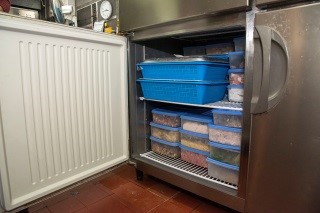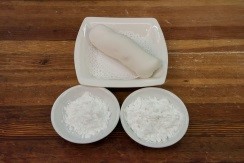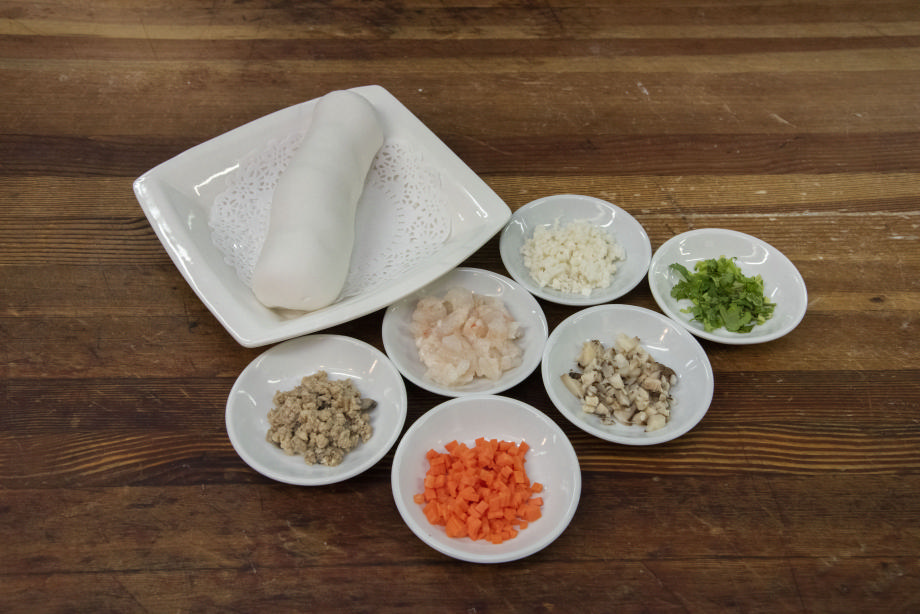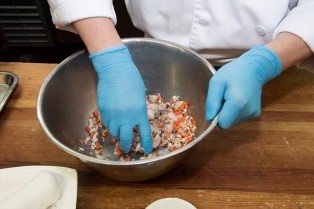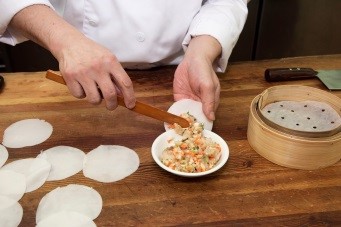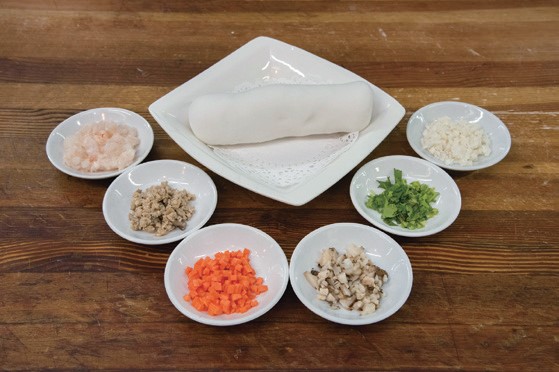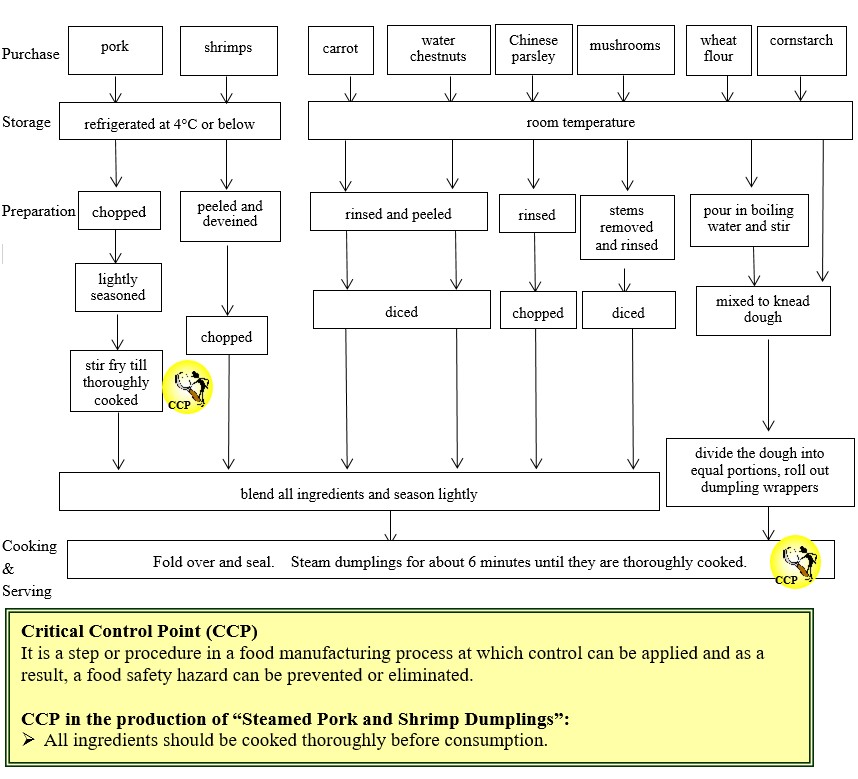
Feature Article
African Swine Fever Is Not a Threat to Food Safety
Mainland China reported its first outbreak of African Swine Fever (ASF) in Shenyang, Liaoning Province on 3 August 2018. In Hong Kong, two ASF cases were discovered in Sheung Shui Slaughterhouse in May 2019. ASF is not a human health threat because it is not a zoonotic disease. However, it is a dreadful disease for pigs and can cause massive deaths of pigs in a short period of time.
What is ASF?
ASF is a serious, highly contagious, viral disease of pigs. It was first discovered in Kenya in the 1920s. According to the World Organisation for Animal Health, ASF outbreaks have also been reported in other parts of Africa, some areas of Europe, South America and the Caribbean. More recently (since 2007), the disease has been reported in multiple countries across Africa, Asia and Europe. ASF only affects pigs and the death rate can reach 100%. As there is no vaccine or treatment for the disease, it remains a severe threat to the pig farming industry.
The disease can be transmitted through direct or indirect contacts between pigs. Once a pig is infected, it can take around 4 to 19 days before the symptoms appear. Although the virus can survive a long time in contaminated meat, it can be inactivated by heating at 70°C for 30 minutes.
ASF does not infect humans
ASF is not a threat to human health as it is a non-zoonotic disease, i.e. an animal disease which does not infect humans. Viruses have surface proteins which must bind to a host cell in order to enter the cell and replicate. Different species of animals have different proteins on the outside of their cells and certain viruses can only bind to the surface of the cells of particular species of animals. The ASF virus can only attach itself to and enter specific cells of pigs but not the human cells. Since the discovery of ASF, there has been no evidence of virus mutation causing cross-species transmission to humans in the past century.
Measures taken against ASF at import control point
As part of the Government’s efforts to prevent ASF from spreading to local pig farms, the Centre for Food Safety has stepped up monitoring of all live pigs imported from the Mainland. For each consignment of imported pigs, there will be a documentary check to ascertain that the consignment is accompanied by a valid health certificate which attests that the pigs do not show clinical signs of ASF, and that the animals are not originated from ASF affected farms/regions. In addition, physical inspections will be carried out on site to ensure that all pigs are physically healthy and do not show clinical signs suggestive of ASF.
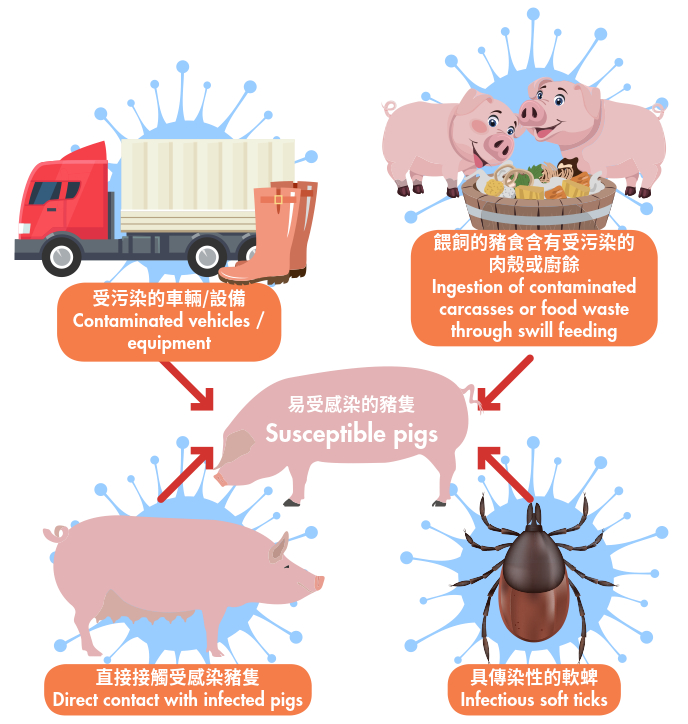
Figure: Transmission routes of ASF
Measures taken against ASF in slaughterhouses
The best strategy against ASF is to block the virus entry through improved biosecurity. Since the outbreak of ASF in the Mainland, the Government has put in place strict biosecurity measures at farms and slaughterhouses to reduce the likelihood of ASF incursion into local farms. The following measures have been enforced to reduce the chance of the ASF virus entering and leaving local slaughterhouses.
Upon arrival at the slaughterhouses, pigs are subjected to ante-mortem examinations, including monitoring the pigs in lairages (animal holding areas) with increased vigilance for signs of ASF and abnormal mortalities. After slaughtering, the carcasses must pass post-mortem inspections by health inspectors to ensure they are fit for human consumption before retail sale. Cleansing and disinfection within the slaughterhouses have been strengthened. To prevent the spread of the disease to local farms, cleansing and disinfection of livestock conveying trucks have also been reinforced.
In addition, a daily clearance arrangement has been implemented in the slaughterhouses, whereby live pigs will be slaughtered within 24 hours upon admittance. By limiting the time pigs stay in the slaughterhouses and enforcing effective cleaning, the risk of infection among pigs in the slaughterhouses can be minimised.
If pigs are suspected to have contracted ASF, samples will be taken and sent to the Veterinary Laboratory of the Agriculture, Fisheries and Conservation Department for testing.
Key Points to Note
- ASF only affects pigs.
- The ASF virus can only infect pig cells and cannot enter human cells, therefore it is not a food safety concern and not a threat to human health.
- As part of the Government’s efforts to prevent ASF from spreading to local pig farms, surveillance measures at the import control point and biosecurity at the slaughterhouses have been strengthened.
Advice to the public
- Purchase meat from reliable and licensed premises.
- Pork should always be fully cooked before consumption as undercooked pork may contain foodborne pathogens.
- Do not bring any game, meat, poultry or eggs into Hong Kong without official health certificates.
- Due to limited supply of fresh pork in the future, chilled and frozen pork can be chosen instead.
Readers' Corner
Histamine Poisoning by Fish and Fish Products
Fish is a common ingredient in many dishes. However, the consumption of fish and fish products containing high levels of histamine may cause scombrotoxin fish poisoning (SFP), also known as histamine poisoning. A total of 26 SFP cases were recorded in Hong Kong over the past ten years.
Formation of histamine in fish and fish products
Histamine is a toxic metabolite attributable to histamine-producing bacteria due to spoilage and fermentation of fish and fish products. Many histamine-producing bacteria are the natural microflora of the skin, gills and guts of freshly caught fish. Histamine-producing bacteria convert the amino acid histidine that are naturally present in fish into histamine.
The histamine level in fish and fish products mainly depends on the fish species and time/temperature control. Certain species of fish like mackerel, sardine, tuna and anchovy naturally contain a high amount of histidine and have been associated with the SFP cases in Hong Kong and/or other places.
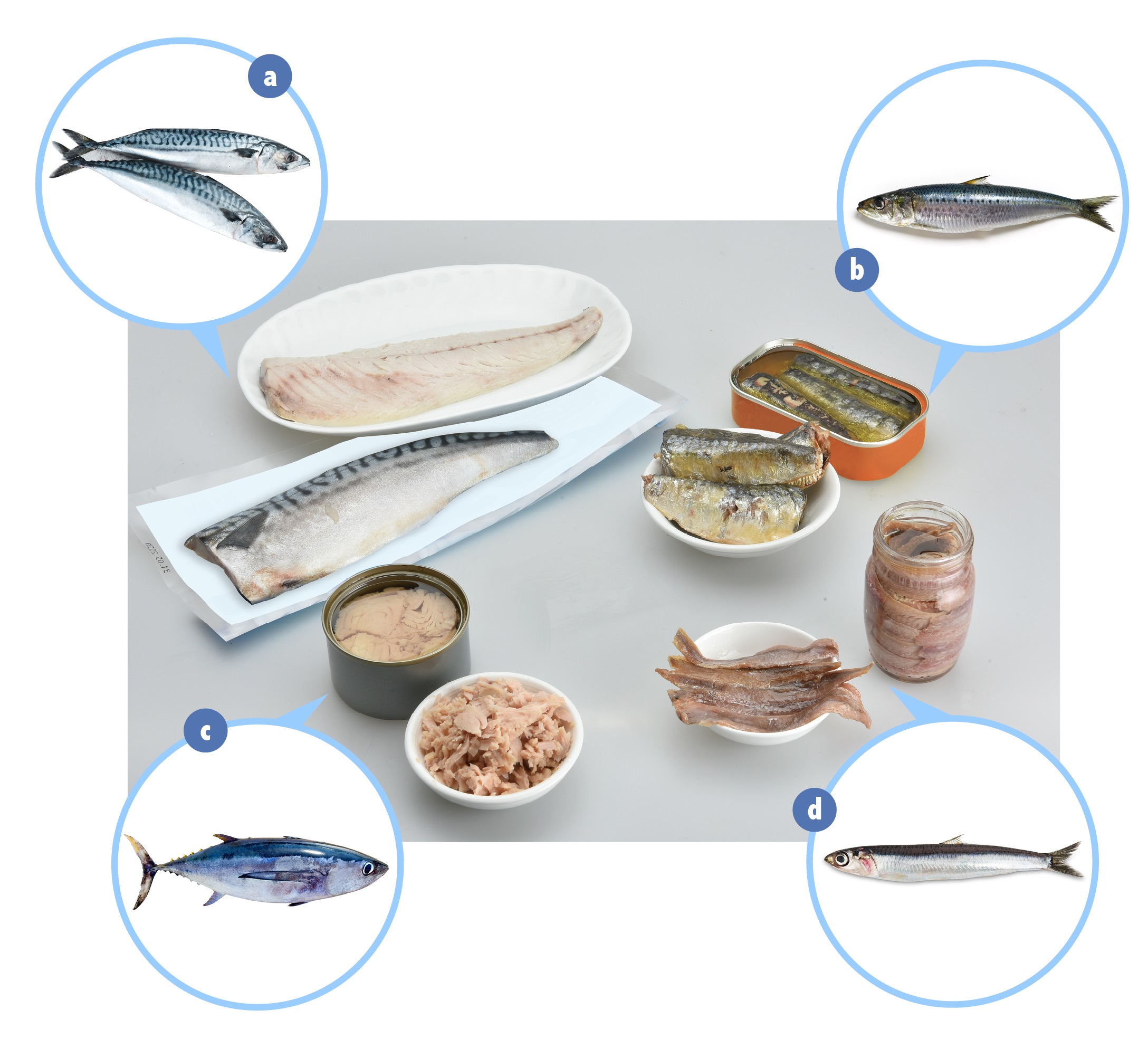
Diagram: Examples of fish with an elevated level of naturally occurring histidine: (a) mackerel, (b) sardine, (c) tuna and (d) anchovy. Some of their respective products have also been found to contain a high level of histamine.
How to ensure that fish species prone to histamine production are safe for consumption?
Time and temperature control is the most effective method to ensure the food safety of fish species prone to histamine production. In the absence of proper time and temperature control, such as lack of refrigeration and freezing, formation of histamine may occur at any point throughout the supply chain. A study jointly conducted by the Food and Environmental Hygiene Department and the Consumer Council revealed that a high level of histamine which could cause SFP was detected in opened canned fish samples left at room temperature for 24 hours. However, histamine was not detected in samples that were kept at 2°C for up to 168 hours.
Health effects of histamine poisoning
SFP is caused by ingestion of food containing a high level of histamine. A serving of 250g of fish or fish products with a histamine level exceeding 200 mg/kg may cause symptoms in healthy individuals. The symptoms of SFP include tingling and burning sensation around the mouth, facial flushing and sweating, nausea, vomiting, headache, palpitations, dizziness and rash. Asthma exacerbation and more serious cardiac manifestations were reported in severe cases. The onset of symptoms is within a few hours after consumption. The symptoms will normally disappear within 12 hours without long-term effects.
How to control histamine levels in fish and fish products to avoid histamine poisoning?
Fish should be chilled rapidly after purchase. Store prepackaged fish and fish products according to the instructions of the manufacturer (e.g. keep the food refrigerated). Cooked fish and ready-to-eat fish products (e.g. tuna fish sandwiches and opened canned fish) placed at room temperature all day long can be recontaminated and histamine may form. If these foods are not eaten immediately, they should be kept under refrigeration and be finished as soon as possible.
Advice to Consumers
- Buy fish and fish products from reputable sources;
- Opened canned fish should not be kept for a prolonged period of time. Leftovers should be properly stored in a clean container, kept refrigerated and consumed within 1 to 2 days. Discard the food if it is not finished within that time;
- Check the shelf life and storage conditions of ready-to-eat fish products when purchasing them. If the refrigerator for storage of ready-to-eat fish products is installed with a temperature indicating device, keep a watchful eye on the storage temperature;
- Ready-to-eat fish products should be consumed as soon as possible after purchase; and
- Leftovers of ready-to-eat fish products should be properly packed and kept at 4°C or below. They should be kept separated from raw food in the refrigerator and be consumed within 1 to 2 days.
News on New Dishes
Steamed Pork and Shrimp Dumplings
Many people love to visit Chinese restaurants to enjoy dim sum (small plates of food served with tea) on holidays. With a wide range of options, dim sum dishes look appealing and appetising. Have you ever thought of making dim sum yourself? In this issue, Mr LAU Pui-shing, Chef of the dim sum section of Canton Room, Gloucester Luk Kwok Hong Kong, a signatory of the Food Safety Charter, will show us how “Steamed Pork and Shrimp Dumplings” is prepared. This is an easy-to-make dim sum in Cantonese style. You can try it as well.
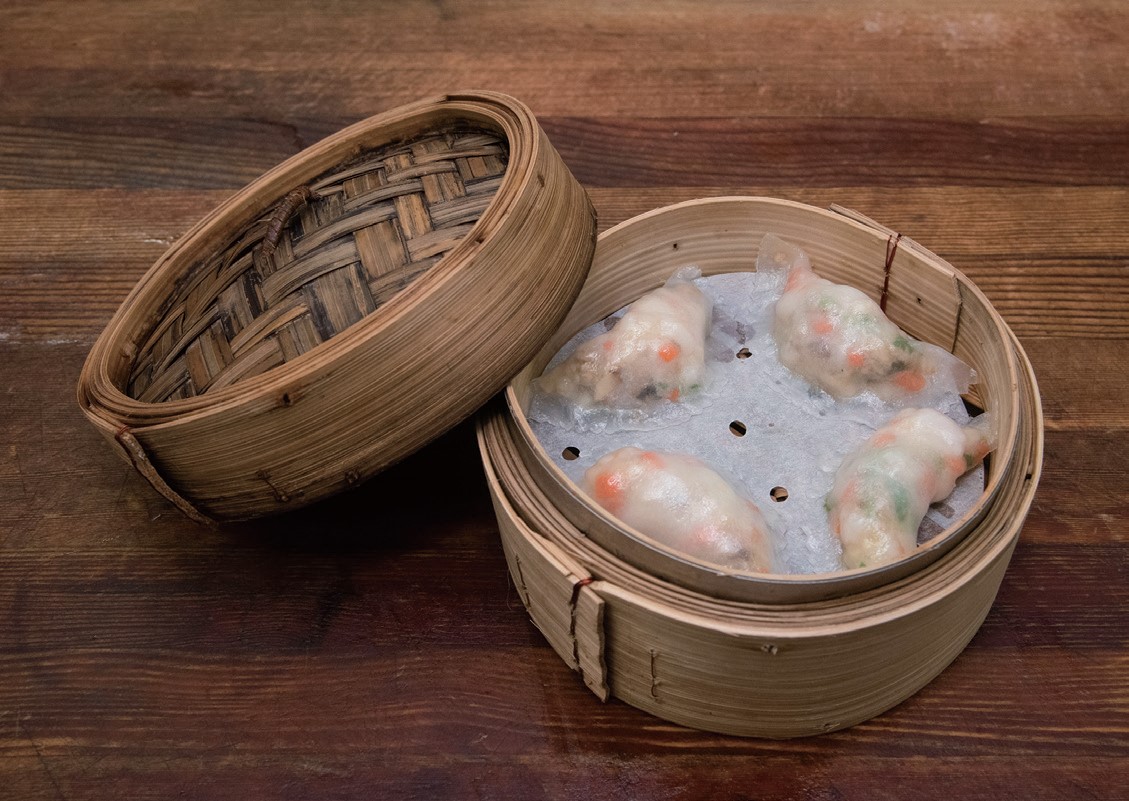
| Preparation Steps | Small Tips, Big Wisdom | |
|---|---|---|
|
Receiving
|
Purchase wheat flour, cornstarch, pork, shrimps, carrot, water chestnuts, mushrooms and Chinese parsley from approved and reliable suppliers. |
Upon receipt of the ingredients, check carefully to ensure their freshness. Pork and shrimps should be refrigerated at 4°C or below. Place carrot, water chestnuts, mushrooms, Chinese parsley, wheat flour and cornstarch on the shelves in an orderly manner. Stick to the “first-in-first-out” principle and use the oldest stock with the shortest shelf life first. |
|
Dough making
|
Pour boiling water into a bowl of wheat flour and stir. Add cornstarch and knead into a dough.
|
When using prepackaged ingredients, remember to check the “use by” date on the packing to make sure the ingredients have not expired.
|
|
Rinsing
|
Rinse carrot, water chestnuts, mushrooms and Chinese parsley thoroughly.
|
Rinsing the ingredients thoroughly under clean running water can effectively remove unwanted substances and reduce the risk of pesticide intake.
|
|
Cutting and cooking
|
Peel and dice carrot and water chestnuts. Remove the stalks of the mushrooms, cut the caps into cubes. Finely chop Chinese parsley. Cut shrimps into small pieces after peeling and deveining. Chop the pork into small pieces and season lightly. Stir-fry till thoroughly cooked. |
Chopping the ingredients into fine pieces can shorten the cooking time. |
|
Mixing
|
Blend all ingredients and season lightly. |
Wearing disposable gloves in food preparation is a convenient way to ensure food hygiene. |
|
Wrapping
|
Divide the dough into equal portions. Roll out dumpling wrappers. Place a moderate amount of filling onto a wrapper. Fold over and seal. |
Bamboo steamers should be cleansed thoroughly to avoid contaminating the food. |
|
Steaming
|
Steam dumplings in a bamboo steamer for about 6 minutes until thoroughly cooked. |
Cooked dumplings should be consumed as soon as possible. If the dumplings are not eaten immediately, they should be cooled quickly and refrigerated within 2 hours. Food left at room temperature for more than 4 hours can allow bacteria to grow easily and should not be consumed. |
Chef's Tips:

Chef LAU has many years of cooking experience. Here are his tips for preparing “Steamed Pork and Shrimp Dumplings”:
- As fresh ingredients have natural flavours, there is no need to add too much seasoning.
- Dumplings taste better when the amount of filling is just right.
- Dumpling wrappers should be evenly rolled out so that the filling can be evenly heated.
Food Safety Plan Corner
Steamed Pork and Shrimp Dumplings (Cantonese Style)
Ingredients:
Pork, shrimps, carrot, water chestnuts, Chinese parsley, mushrooms, cornstarch, wheat flour
Steps:
- Take out cornstarch and wheat flour from the dry goods shelves. Pour boiling water into a bowl of wheat flour and stir. Add cornstarch and knead into a dough.
- Take out carrot, water chestnuts, Chinese parsley and mushrooms from the dry goods shelves. Rinse them thoroughly under clean running water. Peel and dice carrot and water chestnuts. Finely chop Chinese parsley. Remove the stalks and cut mushrooms into cubes.
- Take out pork and shrimps that are refrigerated at 4ºC or below. Cut them into small pieces after peeling and deveining. Chop the pork into small pieces and season lightly. Stir-fry till thoroughly cooked.
- Blend all ingredients and season lightly.
- Divide the dough into equal portions. Roll out dumpling wrappers.
- Place a moderate amount of filling onto a wrapper. Fold over and seal. Steam dumplings for about 6 minutes until thoroughly cooked.
Production Process
Briefing of Activities
Food Safety Charter

The Food Safety Charter is jointly taken forward by the Centre for Food Safety (CFS) and the food trade. Under the Food Safety Charter, the CFS provides information on food safety practices and promotes the “Five Keys to Food Safety”, which are promulgated by the World Health Organization, for facilitation of the signatories in providing Hong Kong citizens and tourists from all over the world with innovative, client-oriented and quality services well-grounded on food safety.
The Five Keys to Food Safety are:
- Choose
- Clean
- Separate
- Cook
- Safe Temperature
You are welcome to become a signatory if you are a member of the food trade, including food trade association, food premises, food retailer and food factory, and will endeavour to:
- promote the “Five Keys to Food Safety” to prevent foodborne diseases, including foodborne infections due to antimicrobial resistance bacteria;
- keep themselves updated on food safety development, enhance food safety and promote the good image of food business; and
- provide safe and healthier food by making reference to the CFS guidelines.
“Food Safety Charter” stickers will be affixed on food premises which are signatories for identification. Members of the public may visit the website of the CFS (https://www.cfs.gov.hk/english/whatsnew/whatsnew_fstr/whatsnew_fstr_food_safety_charter.html) for the Signatory List or the mobile app “Food Safety” for relevant information.

Upcoming Activities
Food Safety Talk on Seasonal Food

With the advent of the Mid-Autumn Festival, various kinds of mooncakes are put on the market. Every year, the CFS collects samples of mooncakes from the market for testing, with a view to monitoring the food safety of seasonal food.
Mooncake manufacturers as well as food importers, distributors and retailers are responsible for ensuring that the mooncakes on sale in the market are safe and fit for consumption.
To this end, we will organise a talk on “Advisory Note on the Import, Manufacture and Sale of Mooncakes” and invite food handlers of food premises to attend so as to enrich their knowledge and enable citizens to enjoy mooncakes which are delicious and safe for consumption in celebration of the festival.
Food Safety Q&A
How Should Lo-mei Be Handled in Order to Be Safe for Consumption?

Chi Chai: Master, when will you teach me how to prepare your signature dish “marinated goose in special sauce”?
Master: Be patient, Chi Chai. Lo-mei is a high risk ready-to-eat food. If it is not handled properly, eaters may suffer from diarrhoea, vomiting and stomach pain. It will be meaningless no matter how yummy it is.
Chi Chai: Then, Master, what should I take note of?
Master: You should remember that although most of the microorganisms present in the thoroughly cooked lo-mei are destroyed, there still exist bacteria, such as the spores formed by Bacillus cereus, which cannot be killed. If cooked lo-mei is left at room temperature for a long time, that is within the temperature danger zone between 4°C and 60°C, the remaining microorganisms and bacterial spores can multiply to a large number and even produce heat-stable toxins. Then the lo-mei will no longer be suitable for consumption. So you should take note of the temperature and time of storage for lo-mei.
We should prepare lo-mei in separate rounds, instead of one go, according to the actual demand, so the display time of lo-mei for sale at room temperature can be shortened. Generally speaking, if properly handled, lo-mei that has been left at room temperature for less than 2 hours can be refrigerated for later consumption. If left at room temperature for over 2 hours but less than 4 hours, it should not be refrigerated but consumed within the 4-hour display time limit. If left at room temperature for more than 4 hours, it should not be consumed anymore but discarded.
Chi Chai: Okay, how about the marinade?
Master: During our business hours, the marinade should be kept at 60°C or above. After preparing the lo-mei, the marinade should be cooled from 60°C to 20°C within 2 hours, and from 20°C to 4°C within 4 hours. After business hours, the marinade should be refrigerated or stored under low temperature. Reheat the cooled marinade thoroughly until its core temperature reaches 75°C or above, or to the complete boil before use. In this way, the risk of food contamination by pathogenic bacteria can be minimized.
Chi Chai: It's by no means simple in preparing yummy lo-mei safe for consumption.
Master: Also remember to use separate utensils to handle raw food and cooked lo-mei to avoid cross contamination. To be a competent chef, you should maintain good personal and working environmental hygiene. Only when you fulfil the key points I said could I teach you the secret recipe for “marinated goose in special sauce”. (Loud laughter)
Chi Chai: Yes, Master, I'll take note of them.
Truth Against Fallacy
Can We Eat Mouldy Food after Removing the Spoiled Parts?
Due to limited resources of the Earth, we are now concerned about environmental protection and getting more “food wise”. But should we scrap the mould off mouldy food and eat the rest to avoid food waste?
What are moulds?
Moulds are fungi that can virtually be found in every environment. The warm and humid climate of Hong Kong is conducive to their growth, but they can also grow at refrigerating temperatures. Moulds reproduce by tiny spores which are invisible to the naked eye and spread through air, water or other means such as food handling. After landing in a suitable environment such as food, the spores can germinate and grow. When the mould colony is large enough, we may see them with naked eyes. However, sometimes we may not be aware that moulds are present in our food, particularly if their colour has a low contrast against that of the surrounding product. For instance, grey patches are readily visible on white bread but difficult to be seen on a dark chocolate cake. Therefore, we may occasionally consume mould contaminated food which appears to be mould-free.
Most moulds are harmless and some are even desirable. In general, acute toxicity resulted from the consumption of mouldy food is unlikely. Nevertheless, certain moulds can cause infection especially in persons with weakened immunity, such as chronic patients. Some others can even produce mycotoxins, which can have acute and/or chronic health effects in humans. For example, aflatoxins can cause acute liver damage and are best known for their potential in causing liver cancer.
What to do with mouldy food? Use it or discard it?
Although moulds are not always hazardous, they generally spoil food and affect the overall quality of the product. However, the major concern of mouldy food is still on whether the moulds can produce mycotoxins. In general, mycotoxin-producing moulds are primarily found in grain and nut crops, but they are also known to be on celery, grape juice, apples and other produce. Inspection by naked eyes is unable to tell if the mould present in food is harmful or not.
Simply removing visible mould from the food surface cannot guarantee food safety because the root of the mould may have already penetrated deeply into the food (see diagram). For some dangerous moulds, poisonous substances are often contained in and around the roots, and in some cases, the toxins may even spread throughout the food. In addition, spoiled food may also have bacteria growing along with the mould. To ensure safety, food should be discarded once mould is found on it, except for food containing moulds that are added deliberately during the manufacturing process.
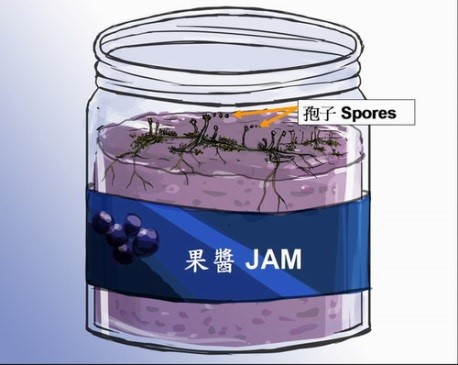
Diagram: The root of the mould can penetrate deeply into the food. Simply removing visible moulds from the surface cannot guarantee food safety.
Advice to the Public:
- To avoid food wastage, we should buy the amount of food we need and use them as soon as possible to prevent food from turning mouldy.
- It is important to keep food covered to prevent exposure to mould spores in the air and possible cross contamination.
- Perishable foods and leftovers should be refrigerated and consumed as soon as possible.
- Other foods should be stored in accordance with the storage instructions provided. If storage instructions are not available, store them in a cool and dry place before consumption.
Quiz
Matching
Nutritious Diet
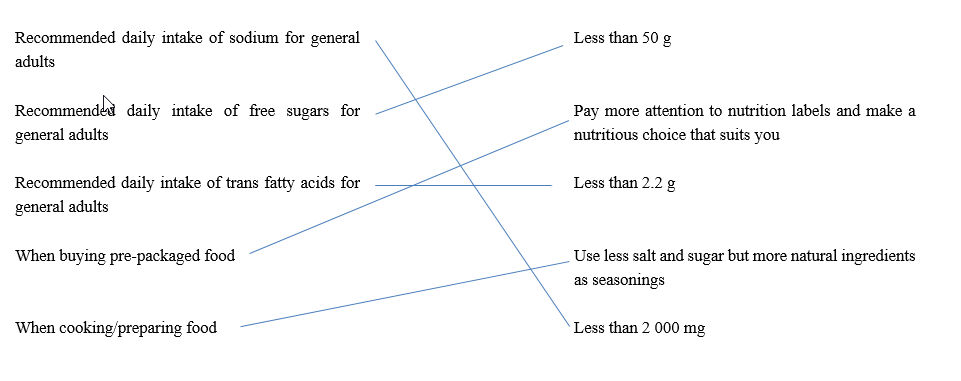
Enquiries and Subscription
Printed copies of the Food Safety Express can be obtained from the Communication Resource Unit at Room 401, 4/F, Food and Environmental Hygiene Department Nam Cheong Offices and Vehicle Depot, No. 87 Yen Chow Street West, Kowloon. For enquiries, please call 2381 6096.
